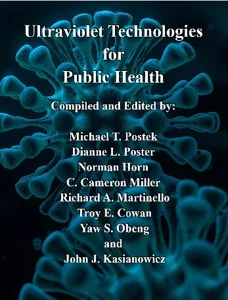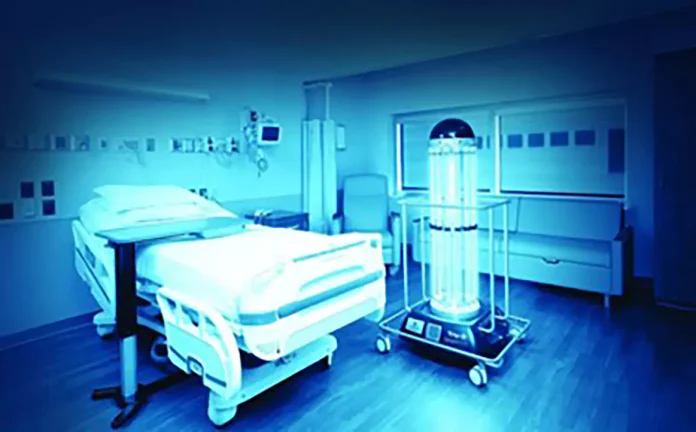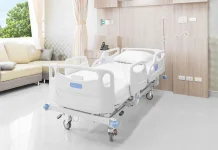By Michael T. Postek, assistant professor, University of South Florida, and Norman Horn, director of research, Seal Shield, LLC
Availability of smartphones and internet access now is so pervasive that most scientific publishing has moved online. Hence, hard-copy printing has seemingly become passé, to some. Electronic publication does have its advantages, but hard copy “shelf item” publications still are needed for many reasons. For instance, not everyone can download, store and retrieve numerous online articles, libraries continue to fill their shelves and many people have a personal preference toward physical paper. But perhaps more importantly, it is advantageous to hand a political official, manager or hospital administrator a glossy printed publication and say: “Look at this! UV disinfection for healthcare is real and effective. Here is the literature to prove it,” and slap it down on their desk. A PDF on a flash drive will not accomplish the same effect.
Ultraviolet Technologies for Public Health is one of those instances. This book is a hard-copy assemblage of state-of-the-art articles from a special section of the Journal of Research of the National Institute of Standards and Technology (J. Res. NIST) which now is archived in a single volume published by the IUVA (https://www.iuva.org/Store). It is the current state-of-the art in UV for healthcare and is a “must have” for anyone in the field.
 Ultraviolet Technologies for Public Health has been divided into four sections: (I) Introduction and perspectives on UV-C in healthcare and beyond, (II) Characteristics and techniques for UV-C disinfection in a variety of application areas, (III) Metrology studies of UV-C, and (IV) Future directions for the field of UV-C disinfection.
Ultraviolet Technologies for Public Health has been divided into four sections: (I) Introduction and perspectives on UV-C in healthcare and beyond, (II) Characteristics and techniques for UV-C disinfection in a variety of application areas, (III) Metrology studies of UV-C, and (IV) Future directions for the field of UV-C disinfection.
The lead paper by Poster et al. reviews the recent history of UV technology in the context of our tumultuous times and provides a summary of the essential role of standards for innovation and implementation of UV-C technology. Dr. Art Kreitenberg and Dr. Richard Martinello, provide a carefully considered perspective on standards for whole-room UV disinfection. Dan Spicer then surveys the field of photonic disinfection in a paper well-suited for both the uninitiated curious person and the seasoned professional.
The papers surveying UV-C characteristics and techniques (Section II) include contributions in UV mechanisms, optics and biological responses to UV energy. Stojalowski and Fairfoull submit a fascinating qualitative investigation into materials that can reflect UV-C light using color-changing paper dosimeters. Blatchley, Petri and Sun present an explanation of available UV-C dose-response data and action spectra for a variety of viruses. Yates et al. contribute a study of UV-C degradation effects of materials used in aircraft interiors, looking at discoloration, strength and flame retardancy, among other properties.
A crucial contribution in this section is the work of Masjoudi, Mohseni and Bolton on the Sensitivity of Bacteria, Protozoa, Viruses and Other Microorganisms to Ultraviolet Radiation. This paper warrants special attention not only because it is the longest in the book (when one counts all the pages of tables) but also because it is arguably the largest and best collection of UV inactivation results in existence today.
Section III focuses on metrology of UV-C. Obeng et al. introduce a unique method of measuring the electrical resistance of biological thin films using microwave broadband dielectric spectroscopy. Fredes et al. present a new mathematical model to estimate irradiance distributions with various UV-C light sources. Zong et al. describe a new technique to measure emissions from light-emitting diodes (LEDs) and laser diodes that they term a mean differential continuous pulse (DCP) method. Sharma et al. explain additional design considerations for devices utilizing UV-C LED sources for surface disinfection. Allen et al. submit an air disinfection study for the special case of Direct Irradiation Below Exposure Limits. Claytor et al. describe their work designing a portable UV-C chamber to disinfect personal protective equipment (PPE) for re-use.
As the COVID-19 threat became a full pandemic, an early hurdle to overcome was extending the lifetime and supply of PPE through disinfection. Disinfecting N95 respirators with UV radiation received major attention, and a few papers in Section III seek to address this challenge. Chandran et al. present design considerations for UV-C devices purposed to disinfect N95 respirators. Poster et al. contribute a comprehensive look at the impact of UV-C irradiation on N95 respirators, discussing virus inactivation data and examining the integrity, form, fit and function of materials following UV radiation exposure. Geldert et al. explain the unique considerations needed to disinfect N95 respirators with UV-C, noting that the porous nature of N95s makes measuring the delivered dose a complicated endeavor.
The concluding section includes two articles that consider future directions for the field of UV-C disinfection. Sarcia contributes a paper modeling air handling system modified with UV-C disinfection equipment. As a capstone, Poster et al. review approaches for collaboration and present model for a UV technology consortium for public health involving industry, academia and government participation.
Ultraviolet Technologies for Public Health will assist in the promotion of this extremely useful and needed technology and now is available at the IUVA.org website store. Get one and slap it down on someone’s desk!






